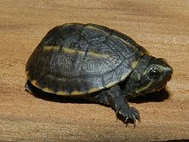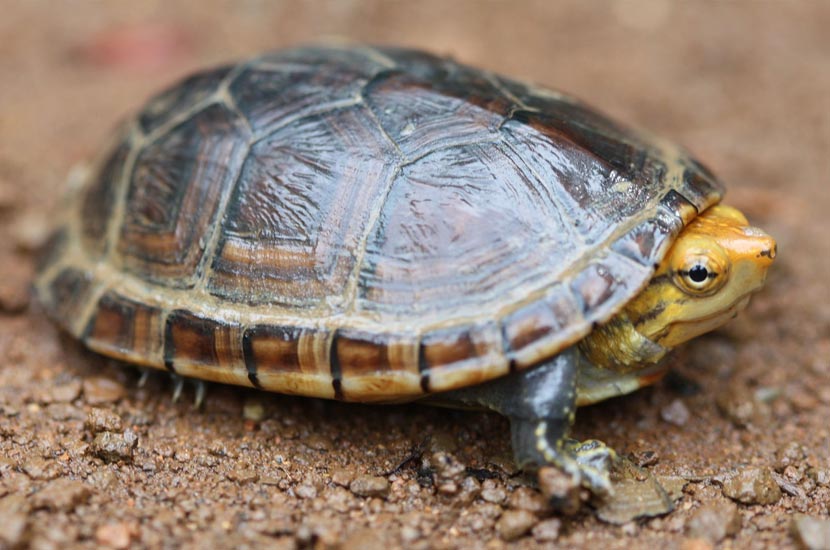Erica Mede, CVT
Natural History
 These small oval shaped turtles are only 3-4 inches long with horizontal yellow stripes along the face and neck. With their tiny size, adorable markings, and fairly large snail crushing head these turtles are quickly becoming a favorite of turtle enthusiasts. Their name comes from the three light stripes on the carapace which may be slightly distorted in hatchlings due to their keels which disappear with maturity. The females are slightly larger than the makes but seldom grow past four inches in length. These small little chelonians are found in the quiet fresh water swamps, canals, and ponds of Florida, Georgia, and South Carolina although other species of Mud turtle can be found throughout the United States .
These small oval shaped turtles are only 3-4 inches long with horizontal yellow stripes along the face and neck. With their tiny size, adorable markings, and fairly large snail crushing head these turtles are quickly becoming a favorite of turtle enthusiasts. Their name comes from the three light stripes on the carapace which may be slightly distorted in hatchlings due to their keels which disappear with maturity. The females are slightly larger than the makes but seldom grow past four inches in length. These small little chelonians are found in the quiet fresh water swamps, canals, and ponds of Florida, Georgia, and South Carolina although other species of Mud turtle can be found throughout the United States .
In 1975, the United States government banned the sale of any chelonian with a carapace (top shell) less than four inches long in hopes of preventing the spread of Salmonella and the destruction of native species in the wild. With the age of easily accessible information via the World Wide Web, private breeders have been successfully breeding and incubating Map turtles and now offer their domestically bred chelonians online. As to the legalities regarding this practice, that is for the government to decide. Domestically bred Map turtles are always recommended over their wild caught counterparts.
Quarantine
It is recommended that all new turtles be quarantined away from the rest of the household chelonians for at least 60-90 days. In this time period the owner can access the animals’ behavior and health status. Chicago Exotics strongly urges owners to bring these animals in during quarantine for a wellness exam and a fecal evaluation. Quarantine requires food, dishes, accessories, and cleaning of the chelonian to be done separately (typically after) from the other chelonians.
Enclosure
 The larger the enclosure for juveniles and adults the better! This species loves to swim and spends larger amounts of time on land than its cousin the Musk turtle. For this reason, it is better to set-up the enclosure to be two thirds aquatic and one third terrestrial.
The larger the enclosure for juveniles and adults the better! This species loves to swim and spends larger amounts of time on land than its cousin the Musk turtle. For this reason, it is better to set-up the enclosure to be two thirds aquatic and one third terrestrial.
Young turtles can be kept in 20 gallon long aquariums but will quickly need to be relocated to a 40 gallon breeder aquarium when they reach the juvenile and sub adult stage. Most adults (especially females) will require a 50-100 gallon aquarium or equivalent enclosure. Some owners opt to create custom enclosures for their pets as well. Generally speaking, there should be 6 inches of aquarium floor per every 1 inch of turtle. If the turtle has a carapace length of 9 inches, it will require 54 inches of aquarium floor space. Other enclosures to consider for multiple turtles include modified plastic tubs, outdoor ponds, and Koi tubs. With a bit of creativity, enclosure potential is endless!
Substrate and Water Quality
With Mud turtles, it is recommended to have a bare tank bottom or with large river stones larger than the animal can consume accidentally. The rocks, however, will require weekly agitation to keep the tank cleaner. Canister filters are recommended by Chicago Exotics for all chelonians as they offer mechanical and biofiltration. Canister filters are generally less stressful to aquatics as there is no mechanical vibration on the tank from the filter body itself. Fluval, Magnum, and Eheim make excellent filters and there are a few websites that illustrate how to create your own canister filter. External filtration helps to remove uneaten food and large waste particles as well as agitate surfaces and increase water oxygenation. An under gravel filter is not enough filtration to maintain a clean environment and will need to be supplemented with other filtration devices. Every 2-4 weeks the rocks should be removed from the tank and disinfected with dilute bleach solution. All cage furnishings should be removed and scrubbed well with a toothbrush designated for the job and bleach diluted 1:20 with water every 2-4 weeks as well.
The water for these turtles is critically important! The water should be twice as deep as the turtle’s length at the deepest part. Change a third of the water once a week to keep the water clean. It is critical to maintain the pH balance between 6.6 – 7.6 and a slightly brackish salinity.
Temperatures
 Typically, the water temperature should be maintained between 74°F and 78°F degrees Fahrenheit. A thermometer in the water is highly recommended at the location furthest away from any heat source and one near the heat source. Water temperature can be maintained using a submersible water heater or under tank heater on a thermostat. If a submersible water heater is used, it is recommended to place a piece of PVC pipe with several holes drilled into the sides of it over the heater to prevent accidental burns and biting. A general rule of thumb is a 75 watt heater will work for a 40 gallon tank, a 55 watt heater for a 55 gallon tank, and a 200 watt heater for a 100 gallon aquarium.
Typically, the water temperature should be maintained between 74°F and 78°F degrees Fahrenheit. A thermometer in the water is highly recommended at the location furthest away from any heat source and one near the heat source. Water temperature can be maintained using a submersible water heater or under tank heater on a thermostat. If a submersible water heater is used, it is recommended to place a piece of PVC pipe with several holes drilled into the sides of it over the heater to prevent accidental burns and biting. A general rule of thumb is a 75 watt heater will work for a 40 gallon tank, a 55 watt heater for a 55 gallon tank, and a 200 watt heater for a 100 gallon aquarium.
The basking light should be over a flat stone such as slate or log. Basking sites should be between 85°F and 92°F and easily accessible to the chelonian. Metal clamp lamps work well for these sites. The ambient temperature of the tank can be increased with under tank heaters and/or the basking lamp as well and maintained at 78-82°F. During the night, under tank heaters or ceramic heat emitters can be used to increase the ambient temperature as it will offer no light.
Light Cycle
As with most reptiles, Mud turtles do well on a light cycle that simulates 12 hours of daylight and 12 hours of darkness. A high quality UVB bulb such as a 5.0 ReptiSun bulb is recommended for adults and a 10.0 ReptiSun bulb is recommended for hatchlings and young turtles. These bulbs help the body convert vitamin D3 into calcium and helps prevent the disfiguring and deadly metabolic bone disease which is generally caused by a lack of available calcium in the reptiles’ body causing the body to absorb calcium from the bones.
Feeding
This species is highly carnivorous preferring to consume fresh water fish (not gold fish) and earth worms in captivity as adults. The key to a healthy turtle is variety in their diet. Small to medium sized fish (not goldfish), insects (crickets, earthworms, red worms), and snails are offered for the meat portion of their diet. Hatchlings are generally fed insects. Supplementation with commercially produced turtle pellets is recommended as well. Some people prefer to feed only commercially produced turtle pellets, in this case, Chicago Exotics recommends feeding multiple brands of turtle pellets or Mazuri Freshwater turtle diet.
In the wild, these chelonians embark on daily foraging expeditions throughout their habitat even stealing food from the mouth of other turtles! In captivity, feeding varies with age and the energy output of the turtle. Hatchlings are fed two times a day as much as they will eat in 10-15 minutes. Adults are fed once a day and as much as they can consume in 10-15 minutes. It is recommended to come up with a standard food amount for adult chelonians to be fed daily to monitor appetite changes. If the water is becoming fouled too quickly or the turtle is becoming obese then the food will need to be decreased. All food should be sprinkled with a multi-vitamin once a week and a calcium supplement daily for hatchlings and three times a week for adults.
Sources and Recommended Readings
Turtles of the World, Carl H. Ernst and Roger W. Barbour
Turtles of the United States and Canada, Carl H. Ernst, Jeffery E. Lovich, Roger W. Barbour
Keeping and Breeding Freshwater Turtles, Russ Gurley
The General Care and Maintenance of Red Eared Sliders and Other Popular Freshwater Turtles, P. de Vosjoli
Aquatic Turtles, David T. Kirkpatrick
Turtles and Tortoises, R. D. Bartlett
Tortoise Trust, www.tortoisetrust.org
If you have any questions, please feel free to call us at (502) 241-4117.

